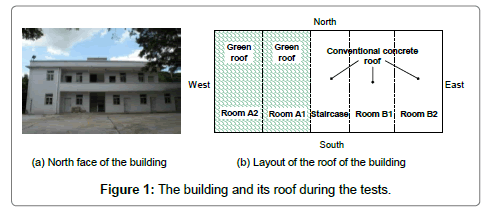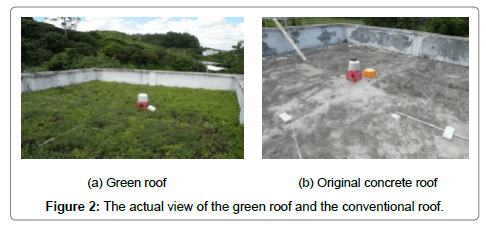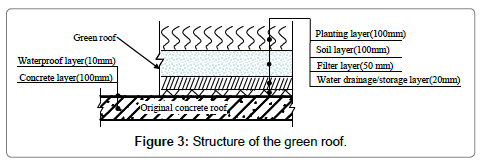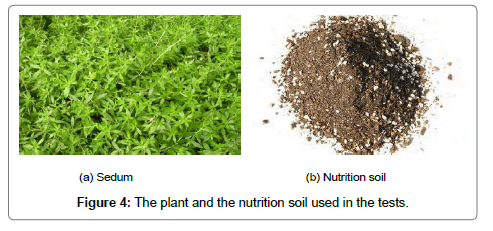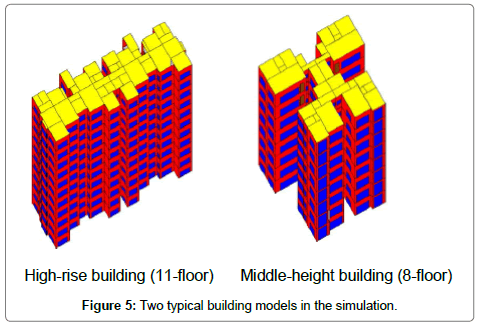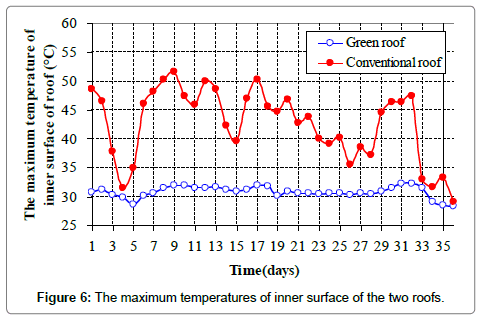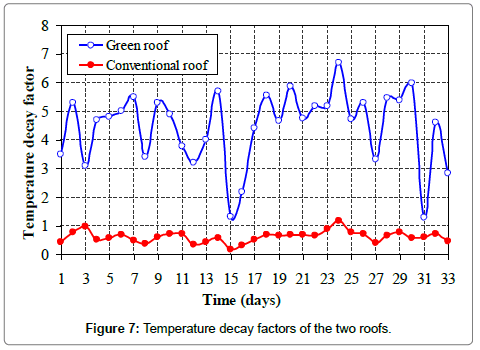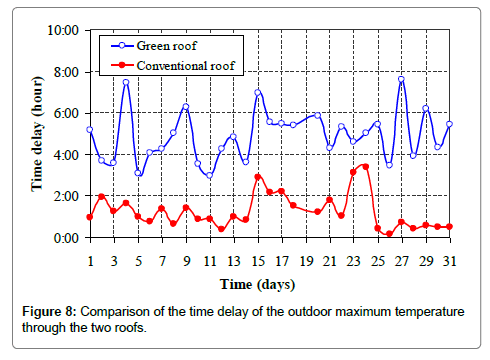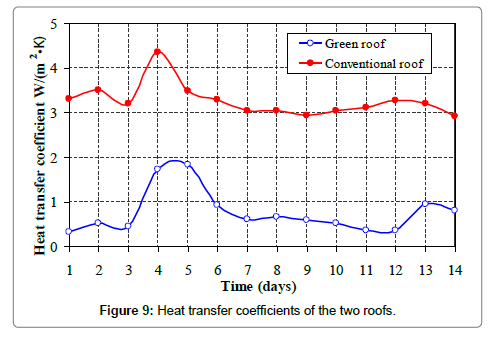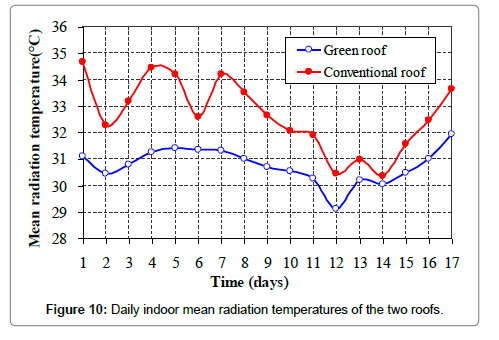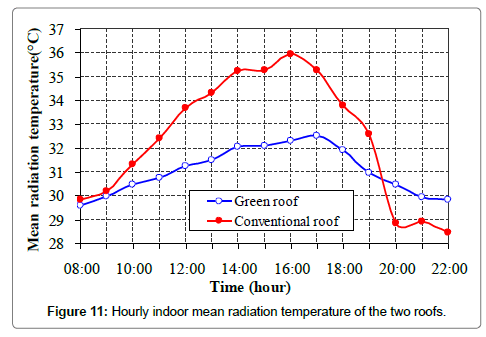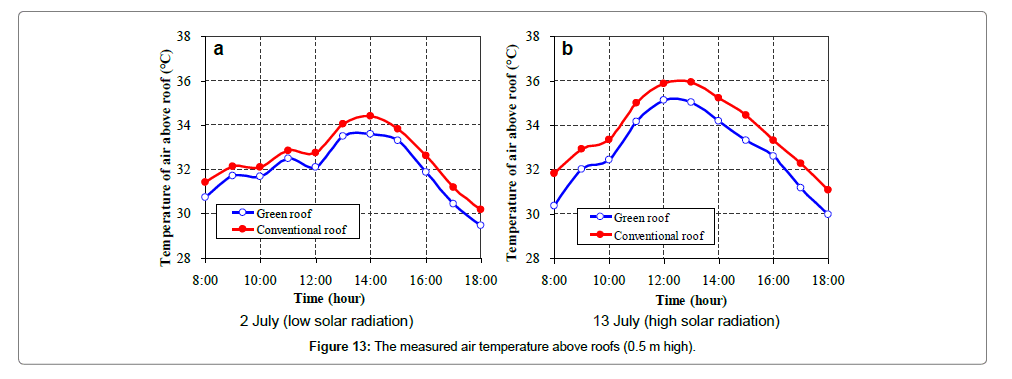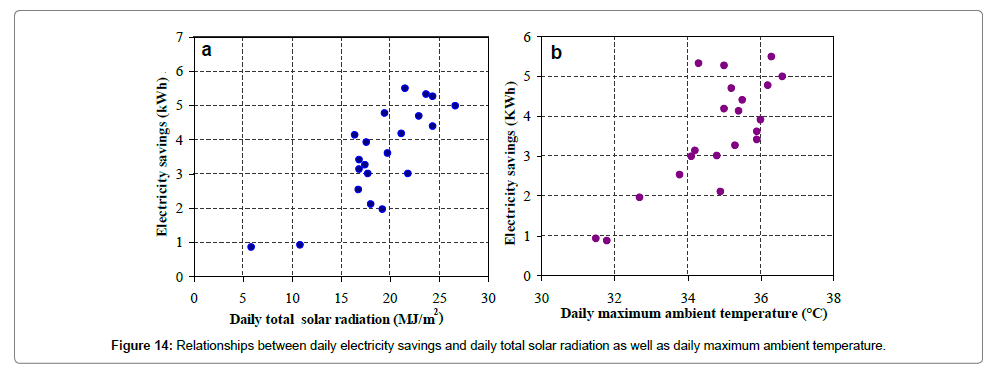Research Article Open Access
Comprehensive Evaluation of Energy and Environmental Performances of an Extensive Green Roof of a Building in Subtropical Climate
Xiaowen Ma1*, Gang Liu1, Zhiqiang Luo1, Yifan Tan2 and Jiangli Lei2
1Shenzhen Institute of Building Research Co., Ltd, Shenzhen, China
2Shenzhen Institute of Landscape Gardening, Shenzhen, China
- *Corresponding Author:
- Xiaowen Ma
Shenzhen Institute of Building Research Co., Ltd, Shenzhen, China
Tel: +86 755 23950586
E-mail: masiama@126.com
Received Date: March 10, 2017; Accepted Date: March 20, 2017; Published Date: March 30, 2017
Citation: Ma X, Liu G, Luo Z, Tan Y, Lei J (2017) Comprehensive Evaluation of Energy and Environmental Performances of an Extensive Green Roof of a Building in Subtropical Climate. J Archit Eng Tech 6: 192. doi: 10.4172/2168-9717.1000192
Copyright: © 2017 Ma X, et al. This is an open-access article distributed under the terms of the Creative Commons Attribution License, which permits unrestricted use, distribution, and reproduction in any medium, provided the original author and source are credited.
Visit for more related articles at Journal of Architectural Engineering Technology
Abstract
Green roof has been investigated to be one of the effective means for improving the building energy performance and relieving the urban heat island (UHI) effect. This study presents a case study in South China with a subtropical climate to evaluate the benefits of extensive green roof to the building energy, indoor and outdoor thermal environment through field tests and simulations. During the field tests in summer, a room on the top floor of a residential building was covered with green roof as the studied room, and another similar room with conventional roof was regarded as the reference room. The field tests showed that the green roof has better thermal behaviors in terms of heat insulation and thermal resistance capacities. The field measurements and thermal voting tests revealed that better comfort indoor thermal comfort and lower outdoor air temperature above the roof (reduction by 0.9-3°C) can be achieved using the green roof. Based on the results of field measurements and simulation study, 32.7% of the mean daily energy was saved by using the green roof for the room studied, and 0.75% of the total electricity consumption of the city was estimated to be saved if 15% of the buildings in the city are covered with green roofs.
Keywords
Green roof; Building energy efficiency; Indoor thermal environment; Outdoor thermal environment
Introduction
The rapid urbanization and the fast increasing of population in cities have resulted in continuous demand for building land, the green area reduction, the increased building energy consumption and the serious urban heat island (UHI) effect. Green roof is one of the effective ways to extend city greening area, weaken city heat island effect [1,2], clean air [3], and improve environment quality and the city ecology environment. A green roof is commonly a roof of a building, which mainly consists of a waterproofing membrane, growing medium and the vegetation layer. Green roof can be divided as extensive green roof (i.e., lightweight green roof) and intensive green roof depending on the depth of planting medium and the amount of maintenance they need. Extensive green roof has many advantages which makes it easier to be used widely, such as simple constructing, light weight, low cost and easy maintenance. It is reported that about 13.5 km2 of green roofs in Germany, which accounts for 14% of the overall flat roofs [4].
During the last two decades, many studies have focused on the thermal and energy performance of green roofs [5-14]. During the studies, Wong [5] conducted a field measurement to investigate the thermal impacts of rooftop garden in a tropical climate in Singapore. The results show that the surface temperature of the rooftop garden is much lower than that of the hard surface, and the heat transfer through the bare roof is greater than that through the planted roofs. Getter [6] studied the seasonal heat flux properties of an extensive green roof in a Midwestern U.S. climate during different seasons of the year. The test results indicate that an average of 13% and 167% of heat flux reduction through the building envelop in winter and summer respectively due to the green roof. Parizotto [7] investigated the thermal behavior of a green roof in temperate climate in Southern Brazil. Their results illustrate that green roof contributes to the thermal and energy benefits of the building under the temperate climate conditions. Up to 97% of heat gain can be reduced using the green roof in comparison to ceramic and metallic roofs during the warm period.
The above studies demonstrate that the green roof has significant contribution to the building energy performance and the building surrounding environment in various climate conditions. The previous studies also show that the building energy benefits from green roofs differ obviously in different climates. It is necessary to further investigate the effect of green roof on the building energy and environment in regions with different climates. This paper therefore aims to provide a case study on extensive green roof in terms of the thermal behavior, energy performance and environment performance in a subtropical climate in Shenzhen city of South China. It is hot with high humidity in summer and warm in winter in Shenzhen. An individual residential building is selected to investigate the thermal and energy effect of green roof on the building as well as the impact on the outdoor environment through field tests. The building energy benefit of the green roof to the overall city is also estimated based on the tests results and simulations.
Research Methodology
Field tests and simulations are used in this study to evaluate the performance of the green roof and its contribution to the enhancement of energy and environment performances of buildings.
Outline of the field tests
The field tests were conducted in Shenzhen, South China. As shown in Figure 1a, this is an office building with two floors, and the rooms on each floor are symmetrical based on the staircase room. There are four rooms on the top floor and each room has identical floor area of 16.8 m2. Rooms A1 and A2 on the top floor of the western side of the building are selected to be covered with the extensive green roof. The roof of the other rooms (i.e., staircase, Room B1 and B2) are still the conventional concrete roof, as shown in Figure 1b. The actual views of the green roof and the conventional concrete surface are shown in Figure 2. During the tests, Room A1 and Room A2 are selected as the test rooms for performance comparison. Room A2 and B2 are used as buffer rooms to reduce the impact of outdoor environment. The indoor air temperatures of Room A2 and B2 were maintained at around 26°C using room air conditioners during the entire test period. The test period lasted 104 days from 1st July, 2011 to 13th October 2011.
Figure 3 illustrates the detailed structure of the green roof used in this study. The extensive green roof is added on the original roof (100 mm concrete layer with 10 mm water proof layer above). The green roof is 270 mm high, which includes water drainage/storage layer, filter layer, soil layer and the planting layer. Sedum is selected as the plant for the studied green roof, which is a widely used plant for green roof with many advantages, such as cheap, drought/cold resistant, and easily maintained. The soil layer employs nutrition soil that is made from waste materials in building construction process. The plant and the nutrition soil are shown in Figure 4.
Research contents and methodologies
This study mainly focuses on the application of green roof in a subtropical region by evaluating its environment and energy benefits for the buildings. Five items are studied in this research as below.
(1) Roof thermal behavior evaluation: Thermal insulation performance and heat transfer performance are the two important indices to character the thermal behaviors of the roof, which affect the energy consumption and indoor thermal environment of building. In this study, field tests are conducted to compare the thermal behaviors of the green roof with that of the conventional concrete roof.
(2) Indoor thermal environment evaluation: The factors that affect the indoor thermal environment include air temperature, relative humidity, indoor air velocity and indoor mean radiation temperature, etc. In a room where only natural ventilation is available instead of airconditioning, indoor thermal comfort is mainly affected by the indoor mean radiant temperature. Various kinds of the roof would result in different indoor mean radiant temperatures under the same outdoor thermal environment. This study will firstly evaluate the indoor thermal environment by comparing the indoor mean radiant temperatures in the room with green roof and the room without green roof (Room A1 and B1) through field tests. Meanwhile, indoor thermal comfort voting by persons is also adopted to evaluate the indoor thermal comfort in these two test rooms. Since the factors affecting the thermal comfort of a person involve clothing, physical situation, and mental situation besides the environment parameters (e.g. air temperature, etc.), thermal comfort voting is a direct and effective way for evaluating the indoor thermal environment from the feeling of persons.
The thermal comfort voting tests lasted one month (July 1 to August 2) during the summer in 2011. Thermal voting tests were conducted during the daytime when the total solar radiation was more than 12 MJ/m2 and the outdoor maximum air temperature is above 33°C. There were 51 persons who voted for their thermal feelings of the two test rooms respectively, of whom 27 were males and 24 were females. The profile of the ages of persons is summarized in Table 1. Since the testing persons may came from extremely different environments before the tests, which may result in significant effect on the test results, they were required to stay in the buffer room (i.e., Room A2) for at least 30 minutes before they came into the test room. During the test, persons firstly came into Room B1 with the conventional roof, and then came into Room A1 with the extensive green roof. The duration in each test room lasted 30 minutes at least.
| Ages | <10 | 10-20 | 21-30 | 31-40 | 41-50 | >50 |
| Number | 1 | 19 | 18 | 7 | 5 | 1 |
Table 1: Age distribution of persons in the thermal comfort voting.
(3) Outdoor thermal environment evaluation: In this study, the outdoor air temperatures at the level of 0.5 m above the roofs of Room A1 and B1 were measured simultaneously to evaluate the effect of green roof on the outdoor thermal environment.
(4) Building energy performance evaluation: Two methods were used in this study to evaluate the building energy performance when using green roofs: the field test and the simulation approach.
For the field test, two identical room air conditioners were installed for air conditioning in the two test rooms (i.e., Room A1 and B1). During the same period and with the same indoor air temperature set-point, energy consumption of the air conditioners in the two test rooms were measured and compared. The energy saving potential of the green roof thus can be determined.
For the simulation approach, energy simulation software (i.e., DOE- 2 in this study) was used to evaluate energy performance of buildings with green roofs when compared to those with conventional concrete roofs. Two typical residential buildings in the city of Shenzhen were selected as the examples to be modeled in the simulation platform: one was a high-rise building with 11 floors, and the other was a middleheight building with 8 floors, as shown in Figure 5. The mean ratios of window to wall were 0.25 and 0.3 of the 11-floor building and the 8-floor building respectively. The building energy consumption of the two typical buildings was calculated using the green roof and the conventional concrete roof respectively. Energy saving potential due to the implementation of green roof therefore can be determined. It is noted that the structures and materials of the green roof and the conventional concrete roof in the simulations were identical as those used in the actual field tests.
(5) Estimated energy benefits to the city: Based on the energy saving potential of the typical buildings resulted from field tests and simulations, this study estimated the energy saving potential contributed by the extensive green roof of the overall buildings in the entire city.
Results and Analysis
Thermal behavior evaluation
Heat insulation performance: The heat insulation of roofs can be evaluated using three parameters: the maximum temperature of indoor surface of the roof, the attenuation and delay of temperature wave through the roof. These three parameters were measured in the two test rooms where air-conditioners were closed and only natural ventilation worked. The tests lasted one month (1 July to 10 August 2011) during the summer.
Figure 6 shows the measured daily maximum temperatures of indoor surface of the green roof and the conventional concrete roof. It can be found that the maximum temperature of indoor surface of the green roof was significantly lower than that of the conventional roof. The maximum temperature difference between the two roofs was 19.7°C, which occurred at a sunny summer day (high solar radiation), and the minimum temperature difference between the two roofs was 1.6°C, which occurred at a rainy day (low solar radiation). Therefore, the capacity of temperature reduction of the roof indoor surface by green roof is more obvious in the sunny summer day with high solar radiation.
Temperature decay is another indicator that can be used to evaluate the heat insulation of the roof, which describes the amplitude reduction of the temperature wave when it passes through the roof. The decay factor is defined as the ratio of the wave amplitude of the outdoor air synthetic temperature (which is a combined value based on the outdoor air temperature and the heat transfer between solar radiation and the external surface of envelops) to that of roof indoor surface temperature. Under the same outdoor thermal environment, a higher temperature decay factor means the better insulation performance of the roof.
Figure 7 compares the decay factor of the temperature wave through the green roof and the conventional roof, respectively. Obviously, the temperature decay factor of the green roof was greatly larger than that of the conventional roof during the test days. The temperature decay factors of the green roof varied between 1.28 and 6.68 with a mean value of 4.44. The temperature decay factors of the conventional roof varied from 0.18 to 1.17 with a mean value of 0.61.
The third factor that can be used to evaluate the insulation performance of the roof is the temperature delay through the roof. During a day in summer, the time when the maximum temperature of the roof indoor surface occurs would be later than the time when the maximum outdoor air synthetic temperature occurs. The time difference between the occurrence of the maximum roof indoor surface temperature and the maximum outdoor air synthetic temperature is defined as time delay. Time delay is dependent on the insulation performance of the building envelope. The longer the time delay is, the better insulation performance of the envelope is. As shown in Figure 8, the time delay of the green roof varied from 3 to 7.5 h with a mean value of 4.9 h, and the time delay of the original roof varied from only 0.2 to 3 h with a mean value of 1.25 h. It is clear that the measured time delay of the green roof was considerably longer than that of the conventional roof in each test day.
Based on the above comparisons and analysis, it can be concluded that the insulation performance of the green roof is better than that of the conventional concrete roof, particularly in the hot sunny-summer days.
Thermal resistance performance: Thermal resistance of the roof can be evaluated using its heat transfer coefficient, which reflects the heat flow through per unit area of the roof. A lower heat transfer coefficient means that less heat transfers between indoor and outdoor environments through the roof, which also means a better heat resistance performance. Therefore, the roof with lower heat transfer coefficient allows less energy consumption of the air-conditioning system of the building.
In this study, the heat transfer coefficients of the roofs of the two test rooms (Room A1 and B1) were determined based on the measured heat flux through roofs and the corresponding indoor and outdoor surface temperature of the roofs. This test lasted 20 days (13 September to 30 September 2011). The air conditioners in the two test rooms began to work two days before the tests. During the tests, the indoor air temperature was lowered down to be at least 10°C below the outdoor air temperature. The measured data were collected after the indoor air temperature was stable. Since the outdoor air temperature was low during night and the temperature difference between indoor and outdoor air temperature could not be maintained at the set-point, only data during daytime were selected for calculating the heat transfer coefficient.
Using the measured data, the heat transfer coefficients of the green roof (i.e., original concrete roof plus the planting layer) and the conventional concrete roof were presented as Figure 9. It is obvious that the heat transfer coefficient of the green roof is significantly lower than that of the original concrete roof, which means less heat transfer through the green roof when compared with the conventional roof under the same conditions. The mean heat transfer coefficient of the green roof was 0.76 (W/m2K), which was only about 20% of that of the conventional roof. Accordingly, the average heat resistance of the green roof was 1.6 (m2K/W), which was around 10 times as that of the conventional roof. Therefore, the heat resistance performance of the green roof is much better than that of the conventional roof.
Indoor thermal environment evaluation
One of the important parameters that affect the indoor thermal environment is the mean radiation temperature, which is defined as a mean temperature that represents the average temperature of all the surfaces in a closed space. In this study, the mean radiation temperatures of the two test rooms were determined based on the temperature measurements of each indoor surface. During the tests, air conditioners were not switched on and the two test rooms were under natural ventilation mode.
The daily mean radiant temperature of each test room is shown in Figure 10. It can be observed that the daily mean radiant temperature of the room using the green roof is obviously lower than that of the room with the conventional roof during the whole test period. The maximum difference of daily mean radiant temperature between the two test rooms was around 3.4°C, which occurred in a hot day with high solar radiation. It is worth noticing that the daily mean radiant temperatures of the two test rooms were very close on the 14th day because that it was cloudy that day with low solar radiation.
A detailed description of hourly mean radiant temperature of the two test rooms in a certain day was presented in Figure 11. There was a sharp increase in the mean radiant temperature of the room using the conventional roof after 10:00 am. The maximum mean radiant temperature of the room using the conventional roof was approximate 36°C, which is significantly uncomfortable. In the test room with green roof, the mean radiant temperatures were relatively stable, varying between about 30°C and 32°C.
Meanwhile, the test of thermal voting was also conducted for evaluating the indoor thermal environment from the viewpoint of human feelings. Persons with various ages stayed at the two test rooms respectively to express their thermal feelings by voting. During the tests, the air-conditioners were closed and only natural ventilation was available. The test results were shown in Figure 12. For the test room with green roof, around 61% of the persons were satisfied with the indoor thermal environment, and only 6% of the persons felt hot. In the test room with the conventional roof, up to 61% of the persons felt hot and uncomfortable, and only 4% of the persons felt comfortable. The test results of the thermal voting indicate that the room with green roof had better thermal environment than that of the room without green roof when under the same outdoor weather condition, which agrees well with the test results of the mean radiant temperature.
Based on the above test results, a better indoor thermal environment can be achieved when the room was covered with the green roof in summer.
Outdoor thermal environment evaluation
Green roof could improve the outdoor thermal environment in summer by decreasing the air temperature above it through plants’ photosynthesis and transpiration during daytime. In this study, the outdoor air temperatures at the level of 0.5 m higher than the green roof and the conventional roof were measured respectively in two summer days (i.e., 2 July and 13 July 2011). The total solar radiation of the two days was 16.29 MJ/m2 and 20.21 MJ/m2 respectively.
Figure 13 presents the measured temperatures of air 0.5 m above the green roof and the conventional roof during two typical summer days. The results in both of the days showed that a lower air temperature above the green roof could be achieved when compared with that above the conventional roof. The difference between the air temperatures above the two roofs varied from 0.9 to 1.6°C on 2 July, and varied from 1.2 to 3.0°C on 13 July. Therefore, a higher reduction of air temperature above the roof was achieved in the day with high solar radiation when using the green roof. This helps to relieve the urban heat island effect.
Building energy performance evaluation
Two methods were used to evaluate the building energy performance using the green roof and the conventional roof: the field test and the simulation test.
Field test results: In the field tests, the energy performance of the two test rooms were evaluated by comparing the measured energy consumption of two identical air conditioners serving the two rooms respectively. The two air conditioners were installed on the same location in the two rooms, and they worked to maintain the indoor air temperature at the fixed set-point (i.e., 26°C). The tests lasted 20 days during the summer from 11 Aug. to 1 Sep 2011.
Table 2 summarizes the energy consumption of the air conditioners in the two test rooms during the typical sunny day. It can be observed that significant energy could be saved in the room using the green roof when compared with the room using the conventional roof. Up to 34.2% (equivalent to 0.27 kWh/(m2 roof)) of the daily energy consumption of air conditioners could be saved due to the use of green roof. Compared with the night period, energy saving potential during the daytime was more obvious. During the whole test period, 32.7% (equivalent to 0.22 kWh/(m2 roof)) of the mean daily energy saving was contributed by using the green roof.
| Energy consumption(kWh) | Energy saving | Energy saving ratio (%) | |||
|---|---|---|---|---|---|
| green roof | conventional roof | kWh | kWh/(m2 roof) | ||
| Sunny day | |||||
| Daytime* | 5.02 | 8.22 | 3.2 | 0.19 | 38.9 |
| Night | 3.62 | 4.91 | 1.29 | 0.08 | 26.3 |
| Whole day | 8.64 | 13.13 | 4.49 | 0.27 | 34.2 |
| Mean daily during the total test period | |||||
| Daytime | 4.11 | 6.8 | 2.69 | 0.16 | 39.6 |
| Night | 3.4 | 4.35 | 0.95 | 0.06 | 21.8 |
| Whole day | 7.5 | 11.15 | 3.65 | 0.22 | 32.7 |
*Daytime indicates the period between 6:00am and 19:30pm.
Table 2: Energy saving potential due to the use of green roof during tests.
Figure 14 describes the relationship between the electricity savings (contributed by the green roof) and the measured total daily solar radiation as well as the daily maximum ambient temperature respectively. Based on the test results, the energy saving potential in the room with green roof closely correlated with the weather conditions. More energy could be saved in the day with high ambient air temperature and strong solar radiation. The daily energy saving was approximately linear to the maximum ambient air temperature and the total daily solar radiation respectively. Through regressing method, mathematical model was established based on the test results to describe the quantitative relationship between the energy saving and the weather parameters, as shown in eqn. (1). The coefficient of determination (R2) of eqn. (1) is 0.7773 that is basically accepted for field tests.
 (1)
(1)
Where, E is daily energy saving, kWh/m2; Tamb, max is the daily maximum ambient temperature, °C, and Sr is the total daily solar radiation, MJ/m2.
It also can be observed from Figure 14 that significant energy saving (contributed by the green roof) can be achieved when the daily solar radiation exceeds 5 MJ/m2 and the daily maximum ambient temperature is larger than 31°C. Based on the typical year weather data of Shenzhen, the days with maximum ambient temperature above 31°C were selected to calculate the annual energy savings of the test room using eqn. (1). The results show that the energy saving of the test room per year is approximately 307.27 kWh, which is equivalent to 18.29 kWh/(m2 roof).
Simulation test results: Simulation tests were also conducted to evaluate the energy saving potential contributed by the green roof. Two typical residential buildings (high-rise building and middle-height building) in the city of Shenzhen were modeled using DOE-2. For each building, the annual energy consumption was calculated using the green roof and the conventional concrete roof respectively under the same boundary conditions. The heat transfer coefficients of the green roof and the conventional roof in the simulations were the same as the measured values of the actual building in the previous field tests.
Table 3 summarizes the simulation results of the energy consumption of the two typical buildings using the green roof and the conventional roof respectively. Compared with the conventional roof, the annual energy savings were 16.88 kWh/(m2 roof) (5.90%) and 15.34 kWh/(m2 roof) (6.20%) of the high-rise building and the middle-height building respectively when using the green roof. The mean energy saving per square meter of the two buildings was 16.11 kWh/(m2 roof), which was very close to the estimated result presented in above section.
| Building | The gross floor area (m2) | Total roof area (m2) | Annual energy consumption (kWh) | Annual energy saving | |||
|---|---|---|---|---|---|---|---|
| green roof | conventional roof | kWh | kWh/(m2roof) | % | |||
| High-rise | 6600 | 600 | 161531 | 171656 | 10125 | 16.88 | 5.90 |
| Middle-height | 2620.4 | 327.6 | 75482 | 80508 | 5026 | 15.34 | 6.20 |
| Average | 4610.2 | 463.8 | 118506.5 | 126082 | 7575.5 | 16.11 | 6.05 |
Table 3: Building energy saving potential by green roof through simulation studies.
Based on the energy savings from the field test result (18.29 kWh/ (m2 roof)) and the simulation result (16.11 kWh/(m2 roof)), an average value of 17.2 kWh/(m2 roof) can be simply derived as the referenced annual energy saving potential due to the use of green roof in the city of Shenzhen.
Estimated overall building energy saving potential in the city
According to the statistical data, there were total 0.193 billion m2 of building roof in the city of Shenzhen in 2009, of which 0.134 (69.4%) billion m2 of the roofs were suitable to be retrofitted with green roof. However, only 1.42 million m2 of the roof had been greened until 2009, which accounted for 0.74% of the total building roofs. Therefore, there are extremely high potentials for applying green roof in this city. In order to estimate the building energy saving potentials by the green roof of the whole city of Shenzhen in summer, two assumed ratios (i.e., 6% and 15%) of green roof to the total roofs are employed respectively in this study. 6% is an accepted roof greening ratio, under which the ecology environment of a city is supposed to be highly enhanced. 15% is a long-term objective that is close to the ratio of green roof in the developed countries, such as Germany.
Table 4 summarizes the estimation of the energy saving contributed by green roofs in the entire city of Shenzhen in summer based on the assumed roof greening rates. 0.2 Billion kWh of electricity would be saved in a year if 6% of the total building is covered with green roofs in the whole city, which accounts for around 0.3% of the total annual electricity consumption of the city. The energy saving could increase to 0.75% (0.5 billion kWh) of the total electricity consumption of the city if 15% of the buildings in the city use green roofs.
| Assumed roofgreening rate(%) | Total green roof area(104m2) | Annual electricity saving | ||
|---|---|---|---|---|
| Per unit(kWh/m2) | Total(104 kWh) | Percentage*(%) | ||
| 6% | 1160 | 17.2 | 19952 | 0.3 |
| 15% | 2899 | 17.2 | 49863 | 0.75 |
*Annual saving percentage by green roofs is determined based on the overall electricity consumption of the city in 2010.
Table 4: Estimated overall building energy savings due to green roof for the entire city of Shenzhen.
Economical and environmental value analysis of light weight roof greening
Based on the electricity price of Shenzhen (0.68 CNY/kWh), 0.136 billion CNY (equivalent to 20.3 million U.S. dollars) would be saved in a year if 6% of the total buildings are used with green roofs. The cost for the total green roofs is about 1.16 billion CNY. Therefore, the payback period for applying the green roof is 8.5 years, which is even shorter if considering the investment reduction of the power transmission network.
The green roof contributes to the ambient environment as well. Around 80,000 tons of standard coal can be reduced due to the energy saving from the green roof under the roof greening ration of 6%, and about 200,000 tons of carbon dioxide emission thus can be reduced.
Conclusion
This paper presents a case study to evaluate the energy and environmental performances of the extensive green roof during summer season in the subtropical climate through field tests and simulations. Some quantitative results in terms of thermal behavior, indoor thermal environment, outdoor thermal environment and building energy performance are summarized as below.
As for thermal behavior, the field tests reveal that the green roof has better heat insulation and thermal resistance capacities. When compared with the conventional concrete roof during the test period of summer, the green roof can reduce the daily maximum indoor surface temperature of the roof by 1.6-19.7°C, achieve the temperature wave attenuation factor of 1.28-6.68, and delay the temperature wave through the roof of 3-7.5 h. The thermal insulation behavior of green roofs performs better in the day with higher outdoor temperature and stronger solar radiation. Moreover, the measured average heat resistance of the green roof was 1.6 (m2K/W) in this study, which was around 10 times as that of the conventional roof.
As for the indoor and outdoor thermal environments, the field tests demonstrates that the daily mean indoor radiant temperature of the room with green roof was significantly lower than that with conventional roof (maximum difference is 3.4°C). In the thermal voting tests under the natural ventilation indoor environment, 61% of persons were satisfied with the indoor thermal environment using green roof when compared with only 6% of persons who felt comfortable in the room with conventional roof. In addition, 0.9-3°C of outdoor air temperature reduction can be achieved at the 0.5 m high level above the green roof in comparison to the conventional roof.
As for the building energy performance, the field tests show that 32.7% (equivalent to 0.22 kWh/(m2 roof)) of the mean daily energy was saved by using the green roof for the test room during the test period in summer. Based on the field test results and the simulation results, it is estimated that the annual energy saving by using the green roof is 17.2 kWh/(m2 roof) when compared with the conventional roof. It is also estimated that 0.75% (0.5 Billion kWh) of the total electricity consumption of the city can be saved if 15% of the buildings in the city are covered with green roofs.
Acknowledgements
The research presented in this paper is financially supported by a grant (2012BAJ12B01-02) of the National Science and Technology Pillar Program during the 12th Five-year Plan Period of China. The authors would like to acknowledge the support of Shenzhen Institute of Landscape Gardening.
References
<
- Doug B, Hitesh D, James L, Paul M (2005) Report on the environmental benefits and costs of green roof technology for the City of Toronto.
- Takebayashi H, Moriyama M (2007) Surface heat budget on green roof and high reflection roof for mitigation of urban heat island. Building and Environment 42: 2971-2979.
- Yang J, Yu Q, Gong P (2008) Quantifying air pollution removal by green roofs in Chicago.Atmospheric Environment 42: 7266-7273.
- Herman R (2003) Green roofs in Germany: yesterday, today and tomorrow. In Greening Rooftops for Sustainable Communities, Chigago,pp: 41-45.
- Wong NH, Chen Y, Ong CL, Sia A (2003) Investigation of thermal benefits of rooftop garden in the tropical environment. Building and Environment 38: 261-270.
- Getter KL, Rowe DB, Andresen JA, Wichman IS (2011) Seasonal heat flux properties of an extensive green roof in a Midwestern U.S. climate. Energy and Buildings 43: 3548-3557.
- Parizotto S, Lamberts R (2011) Investigation of green roof thermal performance in temperate climate: A case study of an experimental building in Florianópolis city, Southern Brazil. Energy and Buildings 43: 1712-1722.
- Santamouris M, Pavlou C, Doukas P, Mihalakakou G, Synnefa A, etal. (2007) Investigating and analyzing the energy and environmental performance of an experimental green roof system installed in a nursery school building in Athens, Greece. Energy 32: 1781-1788.
- Theodosiou TG (2003) Summer period analysis of the performance of a planted roof as a passive cooling technique. Energy and Buildings 35: 909-917.
- Del Barrio EP (1998) Analysis of the green roofs cooling potential in buildings. Energy and Buildings 27: 179-193.
- Eumorfopoulou E, Aravantinos D(1998) The contribution of a planted roof to the thermal protection of buildings in Greece. Energy and Buildings 27: 29-36.
- Wong NH, Cheong DW, Yan H, Soh J, Ong CL (2003) The effects of rooftop gardens on energy consumption of a commercial building in Singapore. Energy and Buildings 35: 353-364.
- Sailor DJ (2008)A green roof model for building energy simulation programs. Energy and Buildings 40:1466-1478.
- Feng C, Meng Q, Zhang Y(2010) Theoretical and experimental analysis of the energy balance of extensive green roofs. Energy and Buildings 42: 653-666.
Relevant Topics
- Architect
- Architectural Drawing
- Architectural Engineering
- Building design
- Building Information Modeling (BIM)
- Concrete
- Construction
- Construction Engineering
- Construction Estimating Software
- Engineering Drawing
- Fabric Formwork
- Interior Design
- Interior Designing
- Landscape Architecture
- Smart Buildings
- Sociology of Architecture
- Structural Analysis
- Sustainable Design
- Urban Design
- Urban Planner
Recommended Journals
Article Tools
Article Usage
- Total views: 3785
- [From(publication date):
April-2017 - Aug 29, 2025] - Breakdown by view type
- HTML page views : 2836
- PDF downloads : 949

